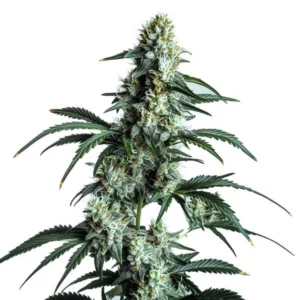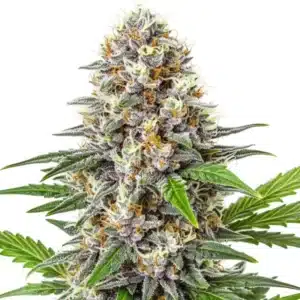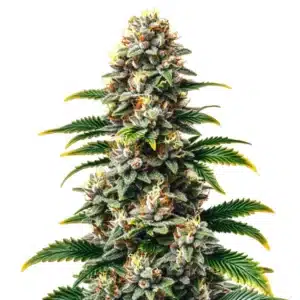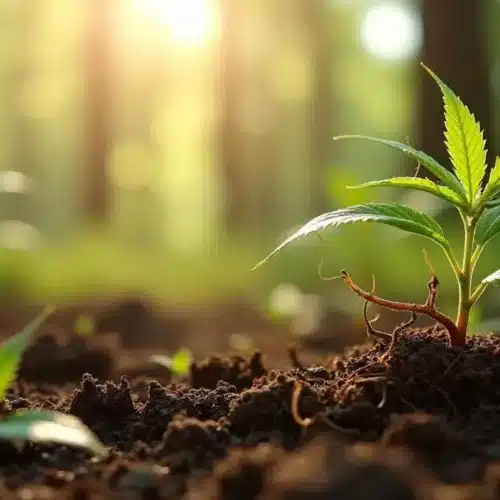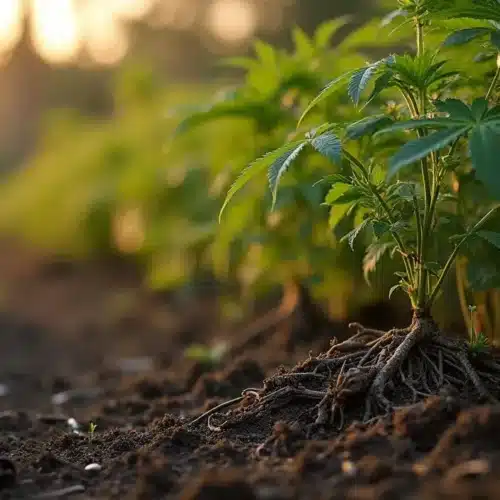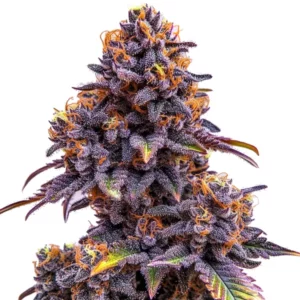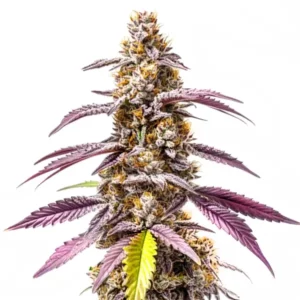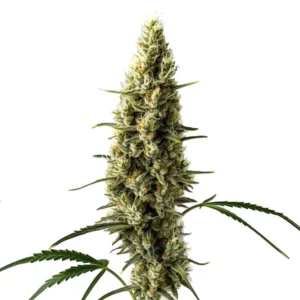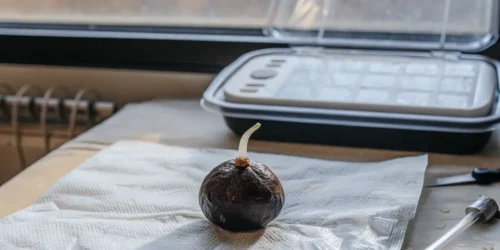Germinating for autoflower seeds is the crucial first step in your cannabis cultivation journey. It’s the moment where potential meets reality, where your seeds transform into thriving plants. But to get the most out of your autoflower seeds, you need to know the best techniques, timing, and conditions for successful germination. This guide will walk you through everything you need to know, ensuring you start your grow on the right foot and maximize your yield.
The Essentials of Germinating for Autoflower Seeds
Before starting this process, it’s important to be familiar with the basics. By preparing everything properly, you boost the chances of a successful and healthy grow.
What You Need to Know Before You Start Germinating Autoflower Seeds
When it comes to autoflowering seed germination, preparation is everything. Unlike photoperiod seeds, autoflowers have a set lifecycle, meaning they don’t wait for changes in light cycles to start flowering. This makes the initial stages of growth, including germination, even more critical.
First, ensure you have high-quality seeds. The genetic quality of your seeds plays a significant role in their ability to germinate and develop into healthy plants. Look for seeds that are firm, dark-colored, and have a slightly glossy surface. Avoid seeds that are pale, cracked, or feel soft when squeezed these are often signs of poor quality or old age.
Next, gather your materials for germinating autoflower seeds. You’ll need clean water, a suitable germination medium (such as soil, paper towels, or starter plugs), and a controlled environment where you can maintain the right conditions for germination. Having everything ready before you start will prevent unnecessary delays and increase your chances of success.
Why Germination is Crucial for Autoflowers
The germination stage is where your autoflower seeds transition from dormancy to active growth. This process sets the foundation for the entire life cycle of the plant. If the seeds don’t germinate properly, they may struggle to grow or produce a suboptimal yield.
For autoflowers, successful germination is particularly important because of their limited vegetative period. Unlike photoperiod strains, which can be kept in the vegetative stage for extended periods to recover from early-stage issues, autoflowers move quickly from seedling to flowering. This means any setbacks during germination can have lasting effects on the plant’s development and final yield.
Knowing the importance of germinating autoflower seeds helps you appreciate the need for precision during this stage. From temperature control to moisture levels, every detail matters when coaxing your seeds into healthy seedlings.
Common Misconceptions About Germinating Autoflower Seeds
There are several misconceptions about germinating autoflower seeds that can lead to frustration and failure. One common myth is that seeds need complete darkness to germinate. While it’s true that seeds don’t require intense light, they don’t need to be kept in total darkness either. A stable environment with indirect light can actually be beneficial.
Another misconception is that seeds should be soaked in water for long periods to improve germination rates. While soaking seeds for 12 to 24 hours can help speed up the process, leaving them in water for too long can cause them to drown or rot. It’s important to strike a balance and move the seeds to a germination medium as soon as they start to crack open.
Finally, some growers believe that germinating autoflower seeds is more challenging than germinating photoperiod seeds. In reality, autoflower seeds can be just as easy to germinate, provided you follow the right steps and maintain the appropriate conditions. By debunking these myths, you can approach germination with confidence and avoid common pitfalls.
Promos & Deals
Proven Methods for Germinating Autoflower Seeds
There’s more than one way to germinate autoflower seeds, and each method has its own advantages. Let’s explore some of the most effective techniques, so you can choose the one that best suits your needs and environment.
The Paper Towel Method for Germinating Autoflower Seeds
The paper towel method is one of the most popular and straightforward techniques for germinating autoflower seeds. It’s simple, effective, and requires minimal equipment.
To start, gather a few sheets of paper towels and soak them in clean, lukewarm water. Wring out the excess water so the towels are damp but not dripping. Place your autoflower seeds between the layers of the damp paper towel, ensuring they are spaced out to avoid contact with each other. Once the seeds are in place, fold the paper towel over them.
Next, place the folded paper towel in a plastic bag or between two plates to create a humid environment. Keep the setup in a warm, dark area, such as a cupboard or drawer, where the temperature remains steady at around 70-75°F (21-24°C). Check the seeds daily to ensure the paper towel remains moist. Within 24 to 72 hours, you should see the seeds begin to crack open and small white taproots emerging.
Once the taproots are about a quarter of an inch long, carefully transfer the seeds to your chosen growing medium. Handle the seeds gently, as the taproots are delicate and can be easily damaged. The paper towel method is highly effective because it provides a consistent level of moisture while allowing you to monitor the progress of germination closely.
Germinating Autoflower Seeds Directly in Soil
Germinating autoflower seeds directly in soil is a more natural method that reduces the need for handling the seeds during the transfer process. This method mimics how seeds would germinate in nature and can lead to a smooth transition from seed to seedling.
To begin, choose a light, well-draining soil mix, ideally one that’s designed for seedlings. Avoid soils that are too rich in nutrients, as this can overwhelm the delicate seedlings. Fill your pots or seed trays with the soil, leaving a small space at the top.
Make a small hole in the soil about half an inch deep. Place your autoflower seed in the hole, with the pointed end facing down. Cover the seed lightly with soil, but don’t pack it down too firmly, as the seedling needs to push through easily. Water the soil lightly to ensure it’s evenly moist, but be careful not to overwater, as this can lead to mold or rot.
Place the pots in a warm, well-lit area where they can receive indirect sunlight or under a gentle grow light. Keep the soil consistently moist, but not soggy. Within a few days to a week, you should see the seedlings begin to emerge from the soil. Do this directly in soil minimizes the stress on the seedling, as it doesn’t have to be moved once it has sprouted, reducing the risk of damage.
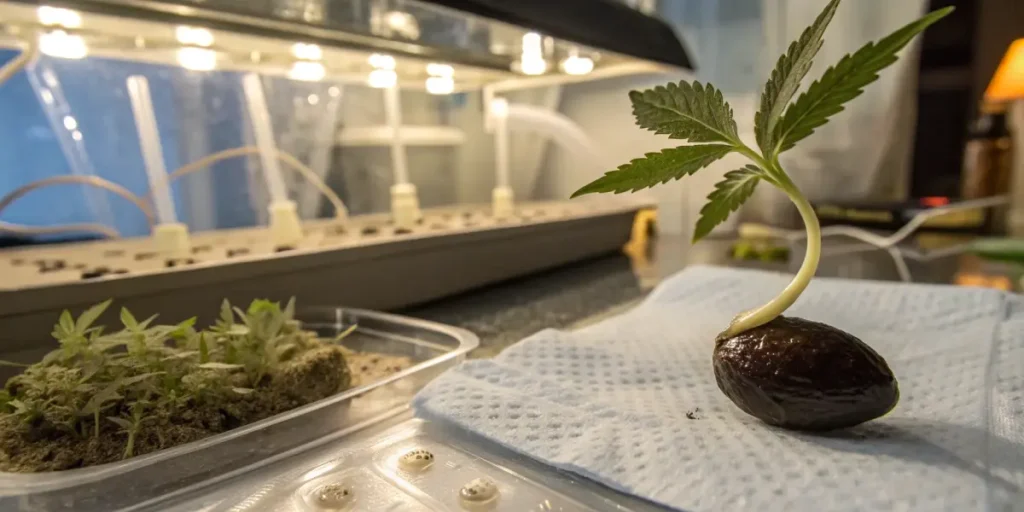
Using Starter Plugs or Pellets for Germinating Autoflower Seeds
Starter plugs or pellets are a convenient option for germinating autoflower seeds, especially for those who want a mess-free and straightforward process. These plugs are made from materials like peat or coco coir and are designed to provide the ideal environment for seed germination.
To use starter plugs, first, soak them in water until they expand fully. Then, insert the autoflower seed into the small hole in the center of the plug. Ensure the seed is just below the surface, and gently pinch the hole closed around the seed.
Place the plugs in a seed tray or germination dome to maintain a high humidity level. Keep the tray in a warm area, ideally around 70-75°F (21-24°C). The plugs will retain moisture well, but it’s important to check them regularly and add water as needed to keep them from drying out.
Once the seeds sprout and the seedlings have developed a few sets of leaves, you can easily transplant the entire plug into your final growing medium. The beauty of using starter plugs for this is that they reduce the risk of damaging the roots during transplantation, as the roots are contained within the plug and can grow freely into the new medium.
Hydroponic Germination Techniques for Autoflower Seeds
For growers using hydroponic systems, germinating autoflowers in water or a hydroponic medium can be an effective approach. This method is ideal for those who want to grow their plants entirely without soil.
To germinate seeds hydroponically, you can start by placing the seeds in a glass of water. Keep the water at room temperature and place the glass in a warm, dark area. After 12 to 24 hours, the seeds should start to crack open. At this point, you can transfer them to a hydroponic germination medium, such as Rockwool cubes or a net pot filled with clay pellets.
Place the germination medium in a seedling tray with a humidity dome, and keep the tray under a grow light set to a low intensity. Maintain the temperature at around 70-75°F (21-24°C) and ensure that the medium stays moist. The seeds should sprout within a few days, and once they have developed a few sets of leaves, they can be moved into the main hydroponic system.
Hydroponic germination allows for precise control over the growing environment, which can lead to faster and more consistent results when germinating autoflower seeds. However, it requires more equipment and careful monitoring to ensure the seedlings have the right conditions for growth.
Creating the Optimal Environment for Germinating Autoflower Seeds
Creating the right environment is key to successfully germinating autoflower seeds. Autoflowers, like all cannabis plants, are sensitive to their surroundings during the germination stage. By controlling factors such as temperature, humidity, light, and water quality, you can significantly increase your germination success rate.
Ideal Temperature and Humidity Levels for Germinating Autoflower Seeds
Temperature and humidity are two of the most critical factors in this. Autoflower seeds germinate best in a warm, humid environment, which mimics the natural conditions they would experience in the wild.
The ideal temperature range for germinating autoflower seeds is between 70°F and 75°F (21°C to 24°C). Temperatures that are too low can slow down the germination process, while excessively high temperatures can cause the seeds to dry out or become damaged. Using a seedling heat mat can help maintain consistent warmth, especially in cooler environments.
Humidity also plays a crucial role. During germination, seeds require a high level of moisture to break out of their shells and start developing roots. Aim to keep the humidity level between 70% and 90%. If you’re using a germination dome or a humidity dome over your seed trays, this can help maintain the necessary moisture levels. Be sure to check the humidity regularly and adjust as needed to prevent the environment from becoming too dry or too wet.
Maintaining the right temperature and humidity is especially important when germinating autoflower seeds, which have a fixed life cycle and less time to recover from suboptimal conditions. By providing a stable environment, you give your seeds the best chance to germinate quickly and healthily.
Importance of Light During Germinating Autoflower Seeds
While light is not essential for the germination process itself, it becomes crucial as soon as the seedling breaks through the soil or germination medium. When planting autoflower seeds directly in soil, ensure the seedlings receive sufficient light as soon as they emerge, since autoflower seedlings need light to start photosynthesis, which is the process by which they convert light into energy for growth.
When using the paper towel method to germinate autoflower seeds, you can keep the seeds in a dark environment until they sprout. However, once the seedlings emerge, they should be placed under a gentle light source to encourage strong, healthy growth. A grow light with low intensity, positioned several inches above the seedlings, is ideal during this stage.
If you’re germinating autoflower seeds directly in soil or using starter plugs, it’s important to provide light as soon as the seedlings begin to emerge. Keeping the light source close to the seedlings will prevent them from becoming leggy or stretched, which can happen if they have to reach for light. Aim for 16-18 hours of light per day during the seedling stage to promote healthy development.
Light also helps to regulate the plant’s internal clock, which is particularly important for autoflowers. Since they transition from vegetative growth to flowering based on time rather than light cycles, ensuring they receive consistent light from the start can help establish a strong foundation for the rest of their life cycle.
Water Quality and pH Considerations for Germinating Autoflower Seeds
Water is another critical component in the process of germinating autoflower seeds, but not all water is created equal. The quality of the water you use can have a significant impact on the success of your germination efforts.
Ideally, the water you use for this should be free from contaminants and have a balanced pH level. Tap water is often treated with chemicals like chlorine, which can inhibit germination and damage delicate seedlings. If you’re using tap water, it’s a good idea to let it sit out for 24 hours before using it, allowing any chlorine to dissipate. Alternatively, you can use filtered or distilled water to ensure purity.
The pH level of the water is also important. Cannabis seeds germinate best in water with a pH of 6.0 to 6.5, which is slightly acidic. If the pH is too high or too low, it can affect the seed’s ability to absorb water and nutrients, leading to poor germination rates. Using a pH meter or pH test strips, you can easily check the water’s pH and adjust it if necessary using pH up or pH down solutions.
By ensuring that your water is of high quality and properly balanced, you provide the optimal conditions for this and developing strong, healthy seedlings.
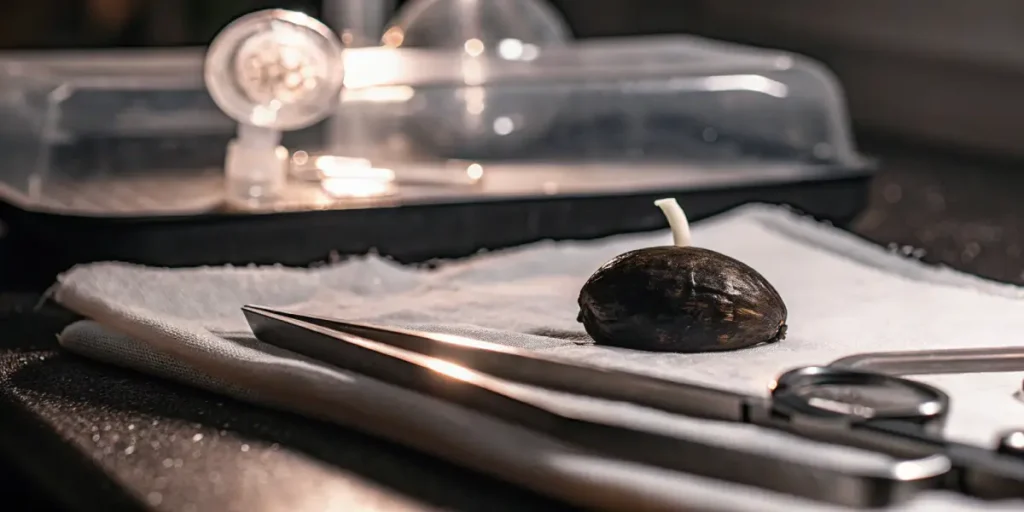
Step-by-Step Guide to Germinating Autoflower Seeds
Now that you understand the importance of the environment and the different methods available, it’s time to walk through the step-by-step process of germinating autoflower seeds. This guide will help you avoid common pitfalls and ensure a smooth start to your cannabis grow.
Preparing Your Seeds for Germination
Before you start the germination process, it’s important to prepare your seeds properly. This includes inspecting them for quality, soaking them if necessary, and gathering all the materials you’ll need.
First, examine your seeds closely. High-quality autoflower seeds are typically dark brown or gray with a hard, smooth surface. They should feel firm to the touch and not crack or crumble when gently squeezed. Avoid using seeds that are pale, green, or have visible cracks, as these are less likely to germinate successfully.
Next, consider pre-soaking your seeds. While this step is optional, soaking seeds in water for 12 to 24 hours can help speed up the germination process by softening the seed coat and allowing water to penetrate more easily. Use clean, room-temperature water and place the seeds in a glass or small container. After soaking, the seeds should begin to crack open, indicating that they’re ready to be transferred to your chosen germination medium.
Gather all your materials before you begin germinating autoflower seeds, including your germination medium (such as soil, paper towels, or starter plugs), water, and any necessary equipment like pH meters or heat mats. Having everything ready will help you work efficiently and avoid unnecessary delays.
Monitoring and Caring for Germinating Autoflower Seeds
Once your seeds are in the germination medium, it’s crucial to monitor their progress closely and provide the right care to support their development.
Check the seeds daily to ensure they’re receiving the proper amount of moisture. The medium should remain consistently damp but not waterlogged. If you’re using the paper towel method to germinate autoflower seeds, check that the paper towels are still moist and add water as needed. If you’re germinating in soil or plugs, make sure the top layer of the medium doesn’t dry out.
Temperature and humidity should also be monitored regularly. Use a thermometer and hygrometer to keep track of the conditions in your germination area. If you’re using a humidity dome, open it occasionally to allow for air exchange, which helps prevent mold and mildew.
As the seeds begin to sprout, be gentle with them. The taproot that emerges is delicate and can be easily damaged by rough handling. If you need to move or transplant the seeds, use clean tools and handle them by the seed coat rather than the root.
It’s also important to watch for any signs of problems, such as mold, slow growth, or abnormal development. Addressing issues early can help prevent them from affecting the overall success of your grow.
How to Handle and Transplant Seedlings
Once your autoflower seeds have germinated and the seedlings have developed their first set of true leaves, it’s time to transplant them into their final growing medium.
If you’re using the paper towel method, carefully pick up each seedling using tweezers or a spoon, making sure to handle the seed and not the delicate root. Prepare small holes in your soil, coco coir, or hydroponic medium, deep enough to accommodate the root without bending it. Gently place the seedling into the hole, cover the root with the medium, and lightly press down to secure it.
For those germinating directly in soil or using starter plugs, the transplant process is even simpler. If your seedlings are in plugs, you can place the entire plug into your final pot or growing system without disturbing the roots. If germinating in soil, carefully lift the seedlings out of the starter container, being mindful of the roots, and transplant them into a larger pot or your hydroponic setup.
After transplanting, water the seedlings lightly and place them under a grow light or in a sunny area where they can receive the light they need to continue growing. Keep the environment stable, with consistent temperature and humidity, to minimize transplant shock and encourage strong root development.
By following these steps for this, you can successfully transition your seedlings from the germination stage to the vegetative stage, setting them up for a healthy and productive life cycle.
Troubleshooting Common Germination Issues
Even with the best preparation, this method doesn’t always go as planned. Here’s how to troubleshoot some of the most common issues you might encounter when germinating autoflower seeds.
What to Do If Your Seeds Don’t Sprout
One of the most frustrating experiences for a grower is when seeds fail to sprout. There are several reasons why this might happen, and realizing them can help you take corrective action.
First, consider the age and quality of your seeds. Older seeds or those that have been stored improperly may lose their viability. If you suspect this might be the case, try soaking the seeds in water with a few drops of hydrogen peroxide for 12 hours before attempting to germinate them again. The peroxide can help soften the seed coat and promote sprouting.
If the seeds are of good quality and still don’t sprout, check your germination conditions. Temperature and moisture are the two most critical factors. Ensure that the environment is warm enough (70-75°F) and that the germination medium is consistently moist but not waterlogged. If necessary, use a heat mat or adjust the humidity levels to create a more favorable environment.
Finally, patience is key. Some seeds take longer to germinate than others, so give them a few extra days before giving up. If after a week there’s no sign of life, it may be time to try a new batch of seeds.
Dealing with Slow or Uneven Germination
Sometimes, seeds will germinate slowly or at different rates, leading to uneven growth among your seedlings. This can create challenges in managing your grow, but there are ways to address this issue.
If you notice slow germination when germinating autoflower seeds, recheck the conditions. Often, low temperatures or insufficient moisture are the culprits. Adjusting the environment can help speed up the process. If one seedling is significantly ahead of the others, you can transplant it into its final medium while giving the others more time to catch up.
For uneven germination, consider using a propagation tray with individual cells, so each seed has its own space to grow. This allows you to transplant seedlings at different times without disturbing the others. Additionally, using a heat mat or placing the slower seeds in a warmer spot can encourage them to catch up.
How to Revive Stalled Germination
Stalled germination can occur when seeds begin to sprout but then stop progressing. This can happen due to a sudden drop in temperature, lack of moisture, or damage to the seed.
To revive stalled germination, first, ensure that the environment is stable and optimal. Increase the temperature slightly and mist the germination medium with water to boost moisture levels. If the seeds are in a paper towel, consider moving them to a more controlled environment, such as a propagation dome, to provide consistent humidity.
If the seedling has started to sprout but isn’t growing further, it may be due to an issue with the seed itself. Gently check the seed for signs of rot or mold. If the root tip is still healthy, try replanting it in a fresh medium with better drainage to prevent further issues.
In some cases, seeds may simply be too weak to continue growing. While not all stalled seeds can be saved, providing the best possible conditions gives them the best chance to recover and continue developing.
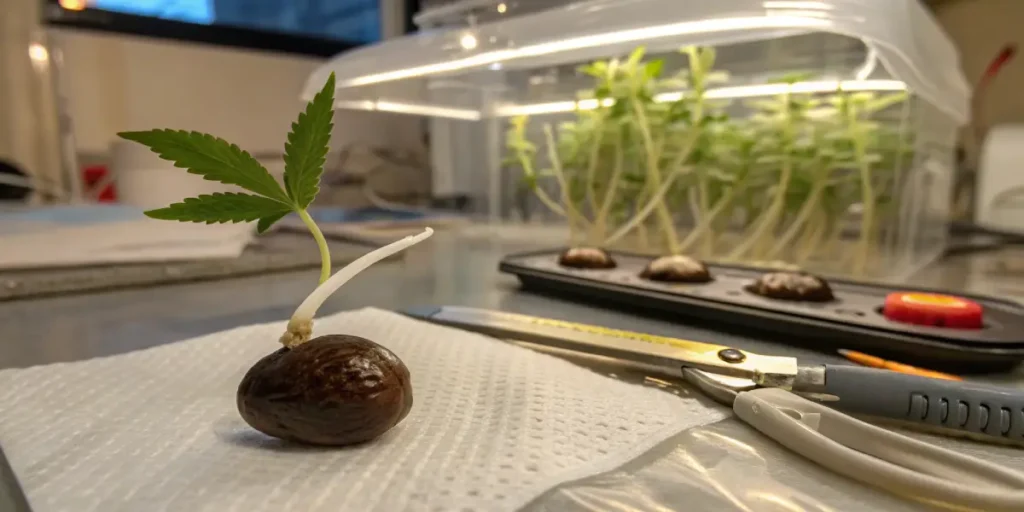
Maximizing Success with Germinating Autoflower Seeds
To boost your success doing this, focus on the following key practices.
Tips for Increasing Germination Rates for Autoflower Seeds
Achieving high germination rates for autoflower seeds involves proper preparation and consistent conditions. Pre-soak seeds for 12-24 hours to soften the seed coat, and maintain optimal temperatures (70-75°F) and humidity levels (70-90%) using a heat mat and humidity dome. Quality germination mediums, such as sterilized soil or starter plugs, help provide a stable environment. Germinating multiple seeds increases your chances of success, ensuring you have healthy seedlings to work with.
Best Practices for Storing Autoflower Seeds Before Germination
Store autoflower seeds in a cool (40-50°F), dark, and dry place to preserve their viability. Use airtight containers with desiccant packets to protect seeds from moisture, and consider vacuum-sealing for long-term storage. Proper storage ensures that your autoflower seeds remain viable and ready for germination whenever you’re ready to start.
Maintaining Healthy Seedlings Post-Germination
After germination, provide seedlings with 16-18 hours of light per day, keeping the light source close to prevent stretching. Water seedlings lightly, maintaining moist but not waterlogged soil. Introduce a gentle breeze with a fan to strengthen stems and start feeding with a diluted nutrient solution once true leaves develop. These practices will help your seedlings grow into strong, healthy plants ready for the next stages of growth.
FAQs
Is light necessary when planting autoflower seeds directly in soil?
No, light is not required for the germination process itself. However, once the seedling emerges from the soil, it becomes essential to provide light so the plant can begin photosynthesis and grow properly.
Why do autoflower seedlings need light after germination?
Autoflower seedlings need light after germination to start photosynthesis, the process that allows them to convert light into energy for healthy growth and development.
How soon should I provide light after planting autoflower seeds directly in soil?
You should provide light as soon as the seedlings break through the soil to ensure they receive the energy needed for photosynthesis and avoid weak or stretched growth.

